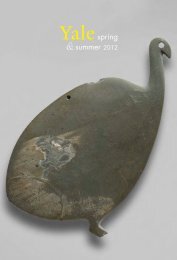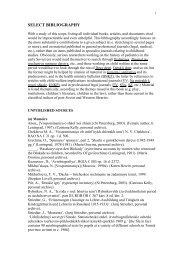View & Download - Yale University Press
View & Download - Yale University Press
View & Download - Yale University Press
Create successful ePaper yourself
Turn your PDF publications into a flip-book with our unique Google optimized e-Paper software.
Kent: North East and East<br />
The Buildings of England<br />
John Newman<br />
Art 47<br />
The exceptionally rich architecture of eastern Kent is covered by this fully revised, updated and<br />
expanded edition of John Newman’s classic survey, first published in 1969. The city of Canterbury<br />
is the county’s greatest treasure, and its glorious cathedral is the first mature example of Gothic<br />
architecture in England. The influence of Canterbury appears also in the remains of St Augustine’s<br />
seventh-century mission churches, and in sophisticated Norman carved work at churches such as<br />
Barfrestone.<br />
Kent is also a maritime county, and its coastal towns are excitingly diverse: the royal stronghold of<br />
Dover with its mighty medieval castle; the medieval port of Sandwich; and resorts large and small,<br />
from genteel Folkestone to lively Margate, with its bold new art gallery.<br />
John Newman’s other volumes for the Pevsner Architectural Guides include Kent: West and the Weald<br />
(2012), Shropshire (2006), and Glamorgan and Gwent/Monmouthshire in the Buildings of Wales<br />
series.<br />
October 800 pp. 216x121mm. 120 colour illus. HB ISBN 978-0-300-18506-5 £35.00*<br />
Northamptonshire<br />
The Buildings of England<br />
Bruce Bailey<br />
Some of England’s grandest country houses are to be found in this prosperous rural county. The<br />
Elizabethan Renaissance Kirby Hall, the Jacobean mansion at Apethorpe, the late 17th-century<br />
French-inspired Boughton, Hawksmoor’s stately Baroque Easton Neston and the interiors of Althorp<br />
provide a fascinating survey of changing taste through the centuries. Complementing them are<br />
smaller buildings of great character, supreme among them those of Sir Thomas Tresham: the eccentric<br />
and ingenious Triangular Lodge at Rushton and the evocative New Beild at Lyveden. Of no less<br />
interest are the fine churches, from Anglo-Saxon Brixworth to the noble Gothic of Warmington,<br />
Rushden and Finedon and from All Saints, Northampton, one of the grandest 17th-century churches<br />
outside London, to Comper’s St Mary’s, Wellingborough. Chief among the towns, Northampton has<br />
not only distinguished Victorian and Edwardian public, commercial and industrial buildings but also<br />
the principal work in England by Charles Rennie Mackintosh.<br />
Bruce Bailey is a Northamptonshire man and has contributed to both of the previous editions of the<br />
guide to the county in this series. He serves as archivist at Drayton House and for the Althorp Estate.<br />
Pevsner Architectural Guides<br />
September 800 pp. 216x121mm. 120 colour illus. HB ISBN 978-0-300-18507-2 £35.00*<br />
Powys<br />
The Buildings of Wales<br />
Robert Scourfield and Richard Haslam<br />
The historic counties of Montgomeryshire, Radnorshire and Breconshire are described in this final<br />
volume of the Buildings of Wales series, expanded and revised from the first edition of 1979.<br />
Prehistoric hill-forts and standing stones, Roman encampments, Early Christian monuments,<br />
ruined castles and the enigmatic remains of early industry enhance the landscapes of this wild and<br />
beautiful region. Atmospheric medieval churches survive in quantity, together with diverse<br />
Nonconformist chapels. Vernacular traditions are represented by robust medieval cruck-framed<br />
houses, and by the manor houses and farmhouses of the Tudors and Stuarts. Other highlights<br />
include Montgomery, with its beguiling Georgian heritage, the Victorian spa at Llandrindod Wells,<br />
and Powis Castle, with its Baroque interiors and terraced gardens.<br />
Robert Scourfield is Buildings Conservation Officer for the Pembrokeshire Coast National Park<br />
Authority, and co-author of Pembrokeshire (2004) and Carmarthenshire and Ceredigion (2006) in<br />
the Buildings of Wales series. Richard Haslam is the author of the first edition of Powys, and<br />
co-author of the Buildings of Wales volume on Gwynedd (2009).<br />
November 800 pp. 216x121mm. 120 colour illus. HB ISBN 978-0-300-18508-9 £35.00*












